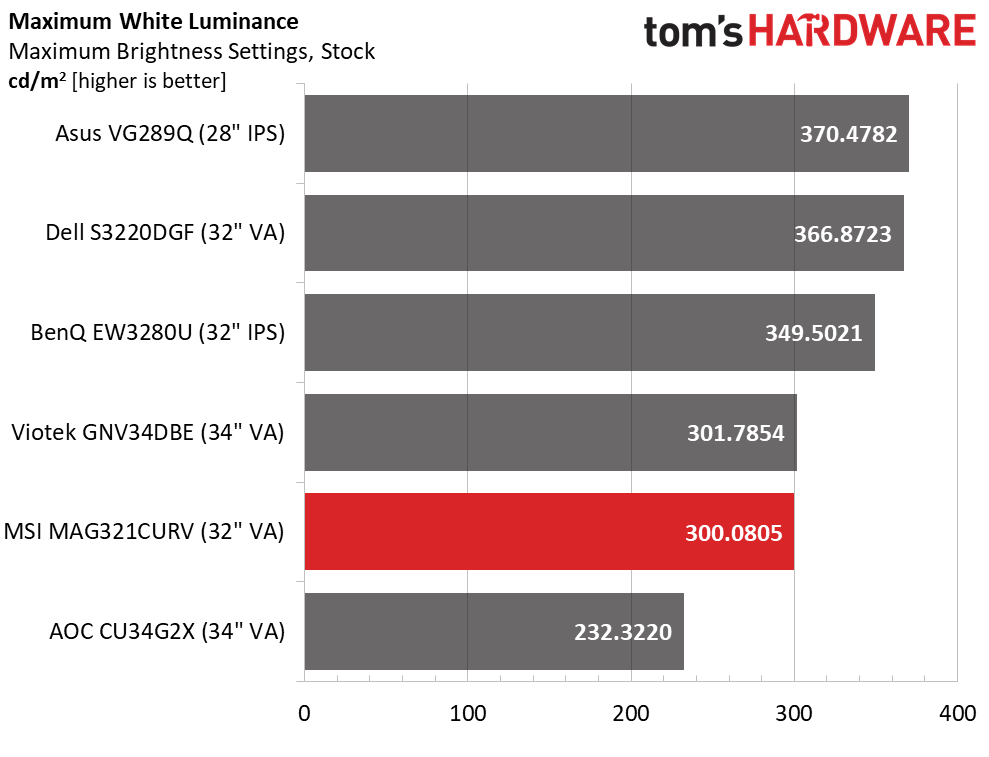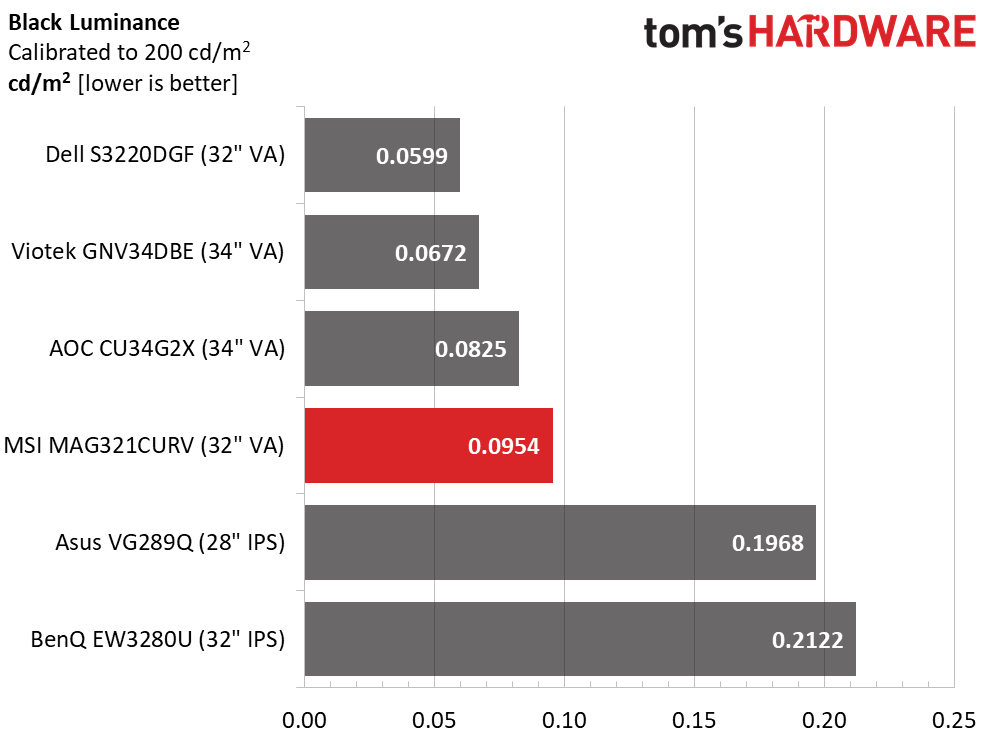Why you can trust Tom's Hardware
To read about our monitor tests in-depth, check out Display Testing Explained: How We Test Monitors and TVs. We cover brightness and contrast testing on page 2.
Uncalibrated – Maximum Backlight Level
The MAG321CURV is somewhat unique in its feature set, so comparisons are a challenge. In price, the Asus TUF Gaming VG289Q comes closest with its 4K resolution and HDR support. Other screens in the 30-35-inch range are the Dell SG3220DGF, BenQ EW3280U, Viotek GNV34DBE and AOC CU34G2X. All of the monitors in the comparison group are VA, except for the BenQ, which uses an IPS panel.



None of the monitors here are particularly bright in SDR mode. Still, 300 nits brightness is enough for any indoor environment, though users would be wise to avoid the sunniest windows. The MAG321CURV delivered decent black levels with a third-place finish, and its static contrast is good enough for a second-place score of 2,607.3:1. It’s the best of the rest after the Dell, which is well ahead of the sample group at over 3,780:1. Obviously, the IPS panels, though good for their category, lag behind the VA displays in our contrast test.
After Calibration to 200 nits



Calibration (see our recommended setting) costs the MAG321CURV a little contrast (2,607:1 versus 2,120:1), but the improvement in grayscale accuracy is worth the sacrifice. Black levels were still low at just 0.0954 nit. Our sample showed some slight uniformity issues, which cost it in the ANSI test. Yes, 1689.9:1 is still a respectable score, but the Dell and Viotek screens kept their intra-image contrast closer to 3,000:1.
MORE: Best Gaming Monitors
MORE: How We Test Monitors
MORE: All Monitor Content
Get Tom's Hardware's best news and in-depth reviews, straight to your inbox.
Current page: Brightness and Contrast
Prev Page Features and Specifications Next Page Grayscale, Gamma and Color
Christian Eberle is a Contributing Editor for Tom's Hardware US. He's a veteran reviewer of A/V equipment, specializing in monitors. Christian began his obsession with tech when he built his first PC in 1991, a 286 running DOS 3.0 at a blazing 12MHz. In 2006, he undertook training from the Imaging Science Foundation in video calibration and testing and thus started a passion for precise imaging that persists to this day. He is also a professional musician with a degree from the New England Conservatory as a classical bassoonist which he used to good effect as a performer with the West Point Army Band from 1987 to 2013. He enjoys watching movies and listening to high-end audio in his custom-built home theater and can be seen riding trails near his home on a race-ready ICE VTX recumbent trike. Christian enjoys the endless summer in Florida where he lives with his wife and Chihuahua and plays with orchestras around the state.
-
burniemac The Philips 328E1CA is a curved 4K 32" VA monitor with adaptive-sync and it's going for $350 on amazon right now. Just a heads up for those interested in this form factor.Reply -
cknobman Honestly surprised they would consider this a gaming monitor with a max 60hz refresh and no adaptive sync.Reply -
Farkle333 Reply
That was my first thought too....60hz ? why would you build a monitor with 1ms response time at 60hz makes no sense at least make it 75 is doable....First thing gamers look at are those 2 numbers.cknobman said:Honestly surprised they would consider this a gaming monitor with a max 60hz refresh and no adaptive sync. -
saunupe1911 Replycknobman said:Honestly surprised they would consider this a gaming monitor with a max 60hz refresh and no adaptive sync.
Yep! Any monitor or even TV for that matter that doesn't have adaptive sync isn't worth the purchase in 2020 unless you positively won't game on it. -
Leo-a-unique-username No point in this review :( 60Hz is not even considerable in 2020 unless it is dirt-cheapReply -
aarondr I've had this monitor for almost a year now. I don't trust the USB hub, which doesn't work with the USB-C port making it practically useless. The USB-C's power is weaksauce (10w) for anything but a tablet, and the OSD software works about 10% of the time. That said, don't be hard on it for lacking a higher refresh rate. 4k isn't there yet - only the most expensive monitors offer >60hz at 4k.Reply
I owned the Samsung UR590C which is the same panel this monitor is based on. The MSI monitor is cheaper, the stand is ridiculously better, port selection is better, and USB-C at least brings another DisplayPort input (to get 10-bit color). A back panel that has relatively unobtrusive light feature and is attractive is also a win over the UR590C which looks and feels cheap. You also get VESA mount compatibility with this display.
I will say the lack of adaptive sync hurts. I expected it considering there are still marketing sites that list it as a feature for this panel (and was hinted at computex 2019 I think). Obviously I was hoping a firmware update might bring it, but I think it was just mis-marketed or the firmware wasn't ready at ship time. I had hope, as Samsung has brought freesync to other monitors, but the UR590C never got it, so I doubt this monitor ever will. I didn't get it for HDR (as it really does suck on this monitor - just a checkbox feature).
There are still quite a few (although it's getting smaller) games out there locked at 16:9 and 60Hz where this monitor shines. Dark Souls, and StarCraft2 are 2 games I play frequently that are locked with these limitations - so this monitor is great for those - especially since framerate isn't a problem, even at 4k. The curve makes for a sublime experience - and I'm happy with my purchase (after selling the UR590C and grabbing this at $350).
I would say the Phillips posted by @burniemac seems to be the real winner here, as it obviously is the same panel (I don't think anyone but Samsung is churning out 1500R 4K 32" panels) with adaptive sync, speakers, and lacks only the USB-C input and arguably useless hub. It's just a shame that MSI couldn't get adaptive sync in their variant, as it would make it better in my opinion if only for the port selection and excellent stand.
If you're considering a 32" 4k curved monitor and you're locked (either due to console or game support) to 16:9, get one of these around $350 - you won't regret it. 4k at 32" is usable in Windows at 100% scaling - which is awesome. Otherwise, 27" 144hz adaptive sync monitors are better for your general gamer IMHO. Just be careful, I have a 27" 144hz, and hard to use despite being a better 'all around' monitor after getting used to the 32". Bigger is better in general use.